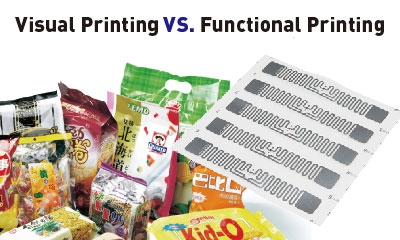Visual Printing VS. Functional Printing

Visual printing refers to the presentation of the print. How well does the print come out visually in front of the audience? Does it serve its marketing purpose of appealing to the audience? On the other hand, functional printing is about the properties and functionalities delivered through the print. How well does it perform to carry out the actions that it is intended to? In this article, we will explore the differences between visual printing and functional printing from their applications and quality assessment methods. At the same time to discuss the scenarios and potential of combining visual printing and functional printing together.
Applications
Some examples of visual printing are the printed image on the packaging of products, the labels on wine and beverages, and the printing on brochures and posters. The purpose of visual printing is to establish communication with the audience or consumers. Vendors hope to have their products stand out from the crowd through visual appeals. To grab the consumer’s attention.
Some examples of functional printing are the conductive silver ink grids on display touch screens, OLED lights, and sensors. Furthermore, the pattern on the RFID tags, and circuits. Depending on the application, functional printing can serve many different purposes, but in general, the purpose of functional printing is to improve electric conductivity, contain electricity as an insulator, and to allow storage and transmission of information.
Quality Assessment Methods
How do we know if a printed result is good or bad? For visual printing, the quality assessments are mostly based on visuals. For example, what is the L*a*b value of the printed colors, what is the delta E value of the print from the original design, what is the opacity of the white ink laydown, and are there visual flaws such as mottle, ghosting, pinholes, and dirty print?
For functional printing, the quality assessments are mainly based on performance metrics. For example, what is the voltage reading from two points, and what is the siemens per centimeter under different temperature and environmental conditions? Depending on the application, there may also be visual metrics involved. For instance, the width of the conductive grids printed, and the width of the insulative lines printed.
Combining Visual Printing & Functional Printing
Visual printing & Functional printing have different goals. However, they can be combined together under different scenarios. For instance, in the logistics industry, RFID tags can be placed on a packaged product for tracking purposes. For the grocery industry, RFID tags can be placed on the outside packaging of the product to provide product resumes to the consumers. In the flexible electronics industry, flexible sensors, displays, and lighting can be produced with the support of functional printing and packaged with visual printing.
As the market asks for more transparency, traceability, and flexibility. In the future, the application of combining visual printing and functional printing is expected to rise.

Article by Daywey Chen, KYMC


























